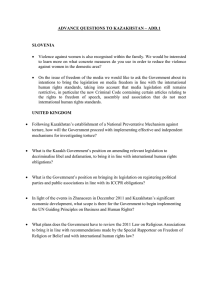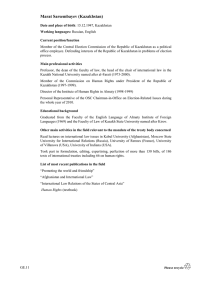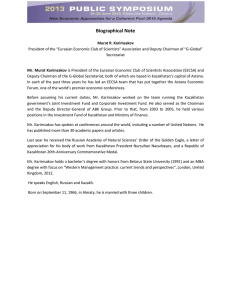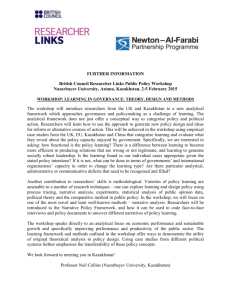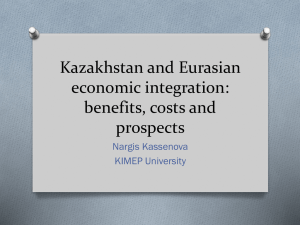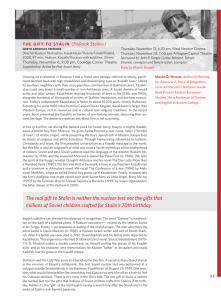49 doc - The Association for the Study of Peak Oil and Gas
advertisement
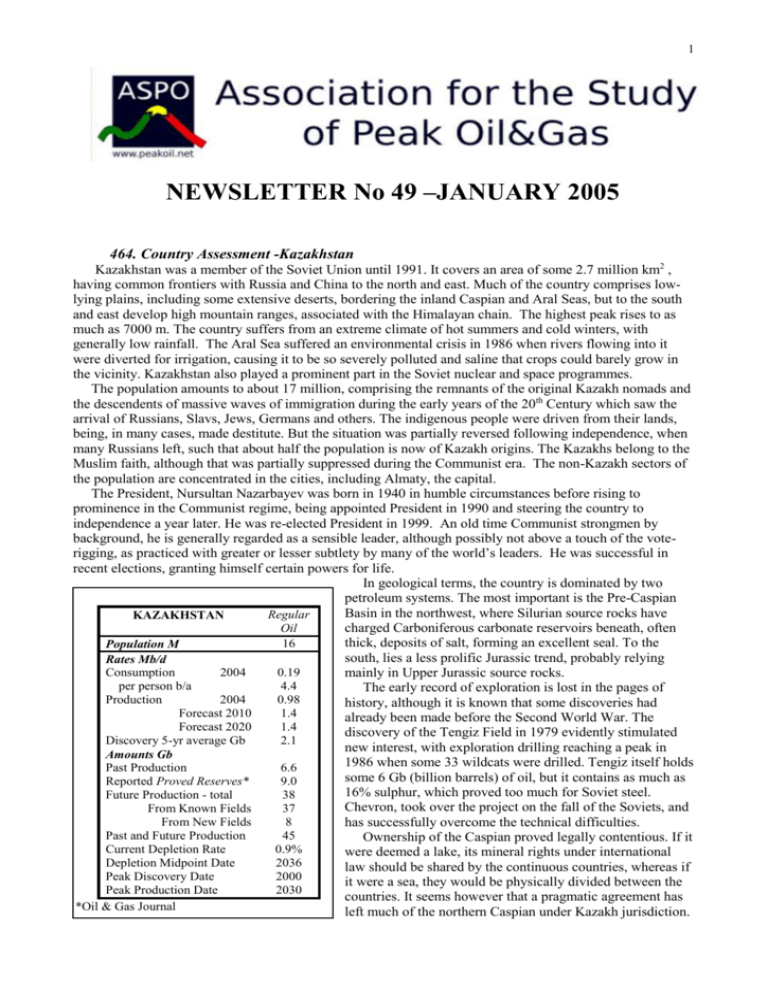
1 NEWSLETTER No 49 –JANUARY 2005 464. Country Assessment -Kazakhstan Kazakhstan was a member of the Soviet Union until 1991. It covers an area of some 2.7 million km2 , having common frontiers with Russia and China to the north and east. Much of the country comprises lowlying plains, including some extensive deserts, bordering the inland Caspian and Aral Seas, but to the south and east develop high mountain ranges, associated with the Himalayan chain. The highest peak rises to as much as 7000 m. The country suffers from an extreme climate of hot summers and cold winters, with generally low rainfall. The Aral Sea suffered an environmental crisis in 1986 when rivers flowing into it were diverted for irrigation, causing it to be so severely polluted and saline that crops could barely grow in the vicinity. Kazakhstan also played a prominent part in the Soviet nuclear and space programmes. The population amounts to about 17 million, comprising the remnants of the original Kazakh nomads and the descendents of massive waves of immigration during the early years of the 20th Century which saw the arrival of Russians, Slavs, Jews, Germans and others. The indigenous people were driven from their lands, being, in many cases, made destitute. But the situation was partially reversed following independence, when many Russians left, such that about half the population is now of Kazakh origins. The Kazakhs belong to the Muslim faith, although that was partially suppressed during the Communist era. The non-Kazakh sectors of the population are concentrated in the cities, including Almaty, the capital. The President, Nursultan Nazarbayev was born in 1940 in humble circumstances before rising to prominence in the Communist regime, being appointed President in 1990 and steering the country to independence a year later. He was re-elected President in 1999. An old time Communist strongmen by background, he is generally regarded as a sensible leader, although possibly not above a touch of the voterigging, as practiced with greater or lesser subtlety by many of the world’s leaders. He was successful in recent elections, granting himself certain powers for life. In geological terms, the country is dominated by two petroleum systems. The most important is the Pre-Caspian Basin in the northwest, where Silurian source rocks have Regular KAZAKHSTAN Oil charged Carboniferous carbonate reservoirs beneath, often thick, deposits of salt, forming an excellent seal. To the 16 Population M south, lies a less prolific Jurassic trend, probably relying Rates Mb/d Consumption 2004 0.19 mainly in Upper Jurassic source rocks. per person b/a 4.4 The early record of exploration is lost in the pages of Production 2004 0.98 history, although it is known that some discoveries had Forecast 2010 1.4 already been made before the Second World War. The Forecast 2020 1.4 discovery of the Tengiz Field in 1979 evidently stimulated Discovery 5-yr average Gb 2.1 new interest, with exploration drilling reaching a peak in Amounts Gb 1986 when some 33 wildcats were drilled. Tengiz itself holds Past Production 6.6 some 6 Gb (billion barrels) of oil, but it contains as much as Reported Proved Reserves* 9.0 16% sulphur, which proved too much for Soviet steel. Future Production - total 38 Chevron, took over the project on the fall of the Soviets, and From Known Fields 37 From New Fields 8 has successfully overcome the technical difficulties. Past and Future Production 45 Ownership of the Caspian proved legally contentious. If it Current Depletion Rate 0.9% were deemed a lake, its mineral rights under international Depletion Midpoint Date 2036 law should be shared by the continuous countries, whereas if Peak Discovery Date 2000 it were a sea, they would be physically divided between the Peak Production Date 2030 countries. It seems however that a pragmatic agreement has *Oil & Gas Journal left much of the northern Caspian under Kazakh jurisdiction. 2 Discovery Gb (shaded) Production kb/d This is highly prospective territory that attracted great interest after the fall of the Soviets, with some reports suggesting it might rival Saudi Arabia. A huge prospect, named Kashagan, was identified, attracting the attention of the veteran New York promoter, Jack Grynberg, who persuaded Mr Nazarbayev to grant rights to a consortium of major oil companies, led by BP, in return for an over-riding royalty, which he may possibly have shared. Operating conditions are appalling, with shallow water impeding the entry of drilling equipment and a frightful wind that coats everything in ice during the winter. If that was not enough, the area lies in the breeding grounds of the sturgeon, an important source of caviar for the Russian market. But eventually wildcats were drilled at either end of the prospect at enormous cost, finding some 9-15 Gb. Although by most standards this would be a fine discovery, BP, Statoil and later British Gas pulled out, turning the operation over to Agip, which left poor Mr Grynberg to sue for his over-riding royalty. Probably, the structure is a huge platform containing discrete reefal reservoirs, separated by rocks lacking sufficient porosity and permeability to be effective. Other structures in the vicinity were later tested successfully, suggesting that overall Kazakhstan has considerable potential. Insufficient is known about the country to make a very reliable assessment but the indications are that Kazakhstan about 37 Gb have been discovered, of which only 6.6 1400 12 have been produced. Future discovery is here 1200 10 assessed at about 8 Gb, giving a rounded total of 45 Gb. With such substantial reserves, the country has 1000 8 little incentive to explore for more. 800 If this is approximately correct, it might be 6 600 reasonable to model production rising to about 1.4 4 Mb/d by 2010 followed by a plateau to the onset of 400 decline around 2030. Since consumption is no more 2 200 than about 200 kb/d, the growth of production implies a massive expansion of export capacity, with the 0 0 1930 1950 1970 1990 2010 2030 2050 construction of new pipelines. The options are to route them through Russia; southwards through Turkmenistan and Iran to the Persian Gulf ; eastwards to China; or westwards to the Black Sea, and onward by tanker or pipeline across eastern Europe through Kosovo, where a large American military base, known as Bondsteel, has been constructed for possibly not unrelated reasons, as even the name suggests. All carry grave geopolitical constraints (see Item 468 below), suggesting that production will not in fact rise as modelled on the resource base, depicted in the table above. It is easy to understand why BP, Statoil and British Gas have pulled out. Approximately 150 Tcf of gas have been found, of which only 26 Tcf have been produced, meaning that the country has substantial export potential, with Russia or China being the obvious main customers. Kazakhstan is in an anomalous position thanks to its remote landlocked location and its history as a former member of the Soviet Union. It evidently has great potential as an exporter of oil and gas, but is likely to face intractable political and geopolitical pressures, which can only grow as alternative world supplies decline in the years ahead. Compiled by C.J.Campbell, Staball Hill, Ballydehob, Co. Cork, Ireland
